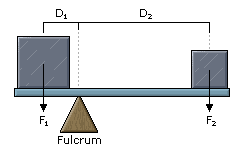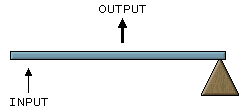
The principle of the lever tells us that the above is in static equilibrium, with all forces balancing, if F1D1 = F2D2.
In physics, a lever (from Old French [1] levier, the agent noun to lever "to raise", c. f. levant [2]) is a rigid object that is used with an appropriate fulcrum or pivot point to multiply the mechanical force that can be applied to another object.
Details[]
This is also termed mechanical advantage, and is one example of the principle of moments. The principle of leverage can also be derived using Newton's laws of motion and modern statics [3].
Early studies[]
The earliest remaining writings regarding levers date from the [3rd century BC and were provided by Archimedes [4]. Give me the place to stand, and I shall move the earth is a remark of Archimedes who formally stated the correct mathematical principle of levers (quoted by Pappus of Alexandria [5]).
In ancient Egypt [6], constructors used the lever to move and uplift obelisks [7] weighing more than 100 tons.
Force and levers[]
The force applied (at end points of the lever) is proportional to the ratio of the length of the lever arm measured between the fulcrum and application point of the force applied at each end of the lever.
The three classes of levers[]
There are three classes of levers representing variations in the location of the fulcrum and the input and output forces.
First-class levers[]
A First-Class Lever is a lever in which the fulcrum is located in between the Effort Force and the Resistance Force, and works by having a force be applied by pulling or pushing onto a section of the bar, which causes the lever to swing about the fulcrum, overcoming the resistance force.
Examples:
- Seesaw (also known as a teeter-totter)
- Crowbar (removing nails)
- Pliers (double lever)
- Scissors (double lever)
- An oar when used for rowing, steering, or sculling
- Wheel and axle because the wheel's motions follows the fulcrum, load arm, and effort arm principle
- Trebuchet [1] an upside down example of the above picture
Second-class levers[]
Examples:
- Wheelbarrow
- Nutcracker (double lever)
Third-class levers[]
Examples:
- Human arm
- Tongs (double lever) (where hinged at one end, the style with a central pivot is first-class)
- Catapult and fishing rod (catapults that act as a see-saw, catapulting their load when something of great mass lands on the board on the opposite side of the fulcrum are first-class levers. Third-class catapults would be similar to the following: take a bobby-pin and bend it so that it looks like the upper-case letter "L." Then, take one arm and staple it to a wooden board. Then bend the free arm towards the stapled arm, and if released, this can be used to send things flying! You have just made yourself a third-class catapult.)
- Any number of tools, such as a hoe or scythe
- The main body of a pair of nail clippers, in which the handle exerts the incoming force
- A rake is also a type of third class lever.
- A baseball bat
- A shovel
- A broom
Mnemonic[]
A mnemonic for remembering the three classes of levers is the word flex, where the letters f-l-e represent the fulcrum, the load, and the effort as being between the other two, in the first-class lever, the second-class lever, and the third-class lever respectively. (To relate the mnemonic to the above diagrams, note that: the "fulcrum" is represented by the triangle, the "effort" is labelled "INPUT", and the "load" is labelled "OUTPUT".)
| This page uses Creative Commons Licensed content from Wikipedia (view authors). | 
|


